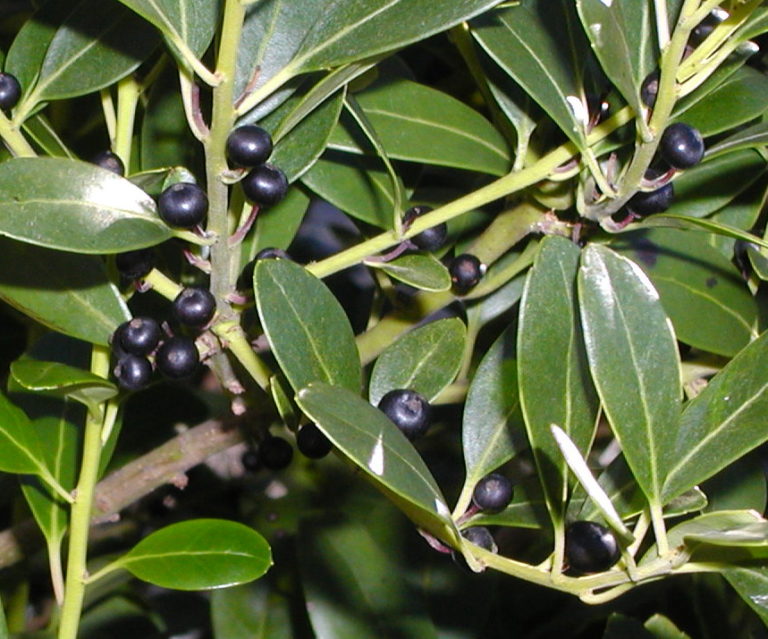Ilex glabra, or Inkberry Holly, is a colonial evergreen shrub with an erect but rounded form, 8 – 10 feet high. If you are not normally fond of prickly holly leaves, Inkberry may be the holly for you: it differs from all other evergreen hollies by lacking spines on the leaves. Inkberry leaves are dark green, shiny, roughly oval, and slightly toothed near the tips. It is a dioecious species, with male and female flowers appearing on separate plants. The flowers of Inkberry are usually 6-petaled, small, white and green (inconspicuous). The male flowers are in clusters, while female flowers are singular. Berries are a black with hints of red. This species is found in the coastal plain of all US states along the Atlantic and Gulf coasts. In NC, it is reported in all lower piedmont and coastal plain counties. Inkberry thrives in rich, consistently moist, acidic soils in full sun, but it adapts really well to a wide range of light regimes (full sun to full shade), moisture levels and soil types, from sandy to heavier, peaty soils. It’s downside is that with age, the lower stems drop their leaves, creating an unattractive, leggy look in a more formal setting, but less important in a naturalistic planting. Inkberry is an understory plant in pine woods, and is stimulated by regular controlled burning, It is said to respond well to shearing for both rejuvenation and height control.
NURSERY HOURS
Wednesday: 10-4 Thursday: 10-6 Friday-Saturday: 10-4 Sunday: 12-4
Ilex glabra

Key Info
Common Names: Inkberry, Gallberry, Bitter Gallberry,Canadian Winterberry, Evergreen Winterberry, Appalachian Tea, Dye-leaves,
Family Names: Aquifoliaceae (Holly Family)
Plant Type: Tree / Shrub
Leaf Retention: Evergreen
Flower Color: White
Additional Info
Habit: Erect, rounded, much-branched, broadleaf evergreen shrub with medium to fine texture, becoming open with age, and leggy below. It is colony-forming, with numerous sprouts from thick, heavy, tuberous rhizomes. If unattended,it will form extensive, dense, thickets.
Height: 5-8'
Spread: 5'-8'
Soil Conditions: Wet, moist, dry; prefers moist, organic, well drained, acidic; sandy, sandy loam, medium loam, clay loam, clay.
Leaves: Alternate, simple, waxy leaves, 1" to 2" long and 0.33" to 0.5" wide, oval in shape, broadest above the middle and finely toothed toward the tip. They are dark to bright green and shiny above, lighter and dull beneath, and can take on a purplish cast in winter.
Flowers (or reproductive structures: Flowers are greenish white, 1/3 inch, not showy, with 5-7 petals. The staminate flowers occur in axillary clusters of 3-7, the pistillate flowers are more often solitary or in 3-flowered cymes in leaf axils.
Fruit: Pea-sized, jet black to reddish, shiny, berry-like drupes 1/4" to 3/8 inch diameter containing 5-7 seeds (pyrenes). Fruits mature in early fall (September/October) and persist throughout winter to early spring unless consumed by birds.
Natural Distribution: Sandy woods and peripheries of swamps and bogs; wet woods, pocosins, savannas, pine barrens.
USDA Hardiness Zone: 5 to 9
USDA Wetland Indicator Status in NC: FAC (fACW on coastal plain)
Pollination: Bees, butterflies, other insects
Wildlife Connections: The nectar of the Inkberry flowers is an important resource for honey production, and it attracts a large numbers of honey bees and other pollinators. The fruits are eaten by at least 15 species of song birds and game birds, including bobwhite quail and wild turkey. The fruits are also important food for raccoon, coyote, and opossum when other sources are scarce. Inkberry leaves are browsed by marsh rabbit and white tailed-deer. Finally, Inkberry provides cover for white-tailed deer, small rodents, and several species of birds.
Propagation: From cuttings or from seeds.
